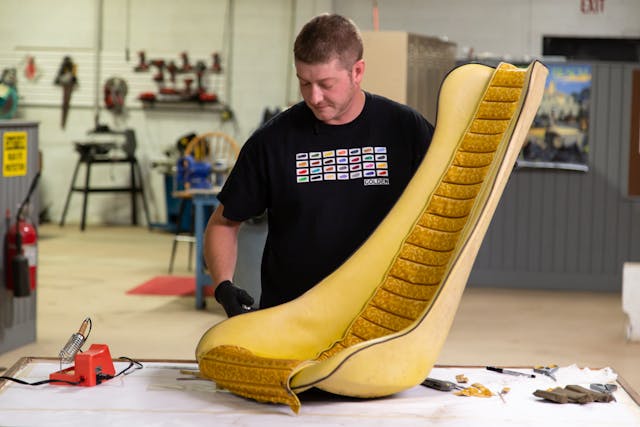Repairing vintage upholstery in George Barris’ 1971 Fun Buggy

How can repairing the upholstery in George Barris’ 1971 Fun Buggy Phase II be anything but fun? Collin Howard certainly seems to be enjoying himself in the fifth episode of The Conservator’s Mindset, a video docuseries from the Historic Vehicle Association.
Faced with a 3-inch tear and a 3-square-inch hole in the Buggy’s passenger seat upholstery, the lead technician at Pennsylvania’s B.R. Howard & Associates shows us how to make a repair that’s practically unnoticeable. But first, Howard warns that in this particular case, “It’s just for visual aesthetics; this won’t be strong enough to be sat on again. This car will now only be used as a showpiece.”
Howard’s skill and patience make it so. First, he removes the seat so that he can assess the damage from the front, then he carefully removes the fabric and padding so he can peek at the backside of the tear, where most of the repair will be done.

“Of course, we would first try to find vintage [material] or the same-patterned material, but in the 1970s they were using such crazy stuff—especially with Barris,” he says.
Oh, oh. You know what that means. “You just can’t find this table lace anymore. It’s just not around.”
But then … “When I was taking the seat apart, I realized how much extra material was under the seat and not even seen … so I started toying with the idea of maybe using a little bit of that extra fabric to make the repair.”
After consulting with the Fun Buggy’s owner, and the two agree that the best course of action is “to cut off 4–5 inches of the original material underneath and use that as our patch.”

Howard creates a template, traces it onto the fabric, and cuts out the replacement patch. He glues it from the backside using thermo-set resin, a glue that he says is “heat reversible and solvent reversible.” The glue comes in gel form, so he melts it into a liquid, sprays it onto PH-neutral polyester fabric, and cuts it into tiny pieces before working it into the crevices with a heat spatula.
Focusing on the front side, Howard says, “It’s close, but it’s not quite there.” He adds more resin—using very small pieces that “fill the seam flawlessly”—and finishes the conservation project by mixing colors to match the original upholstery and then painting the repaired area. Presto. “From 4–5 feet away, you’ll never see it,” he says. “It will just blend right in.”
It seems that a conservator’s best work can’t be seen.

The Conservator’s Mindset is part of the HVA’s Drive History video initiative, which showcases veteran preservationists, historians, and automotive experts and also features vehicles in the National Historic Register. Videos are scheduled to be released every Wednesday.
We’ll be sure to keep you posted about each new episode; you can also stay in the loop by following the HVA on Facebook, Instagram, and Youtube.

